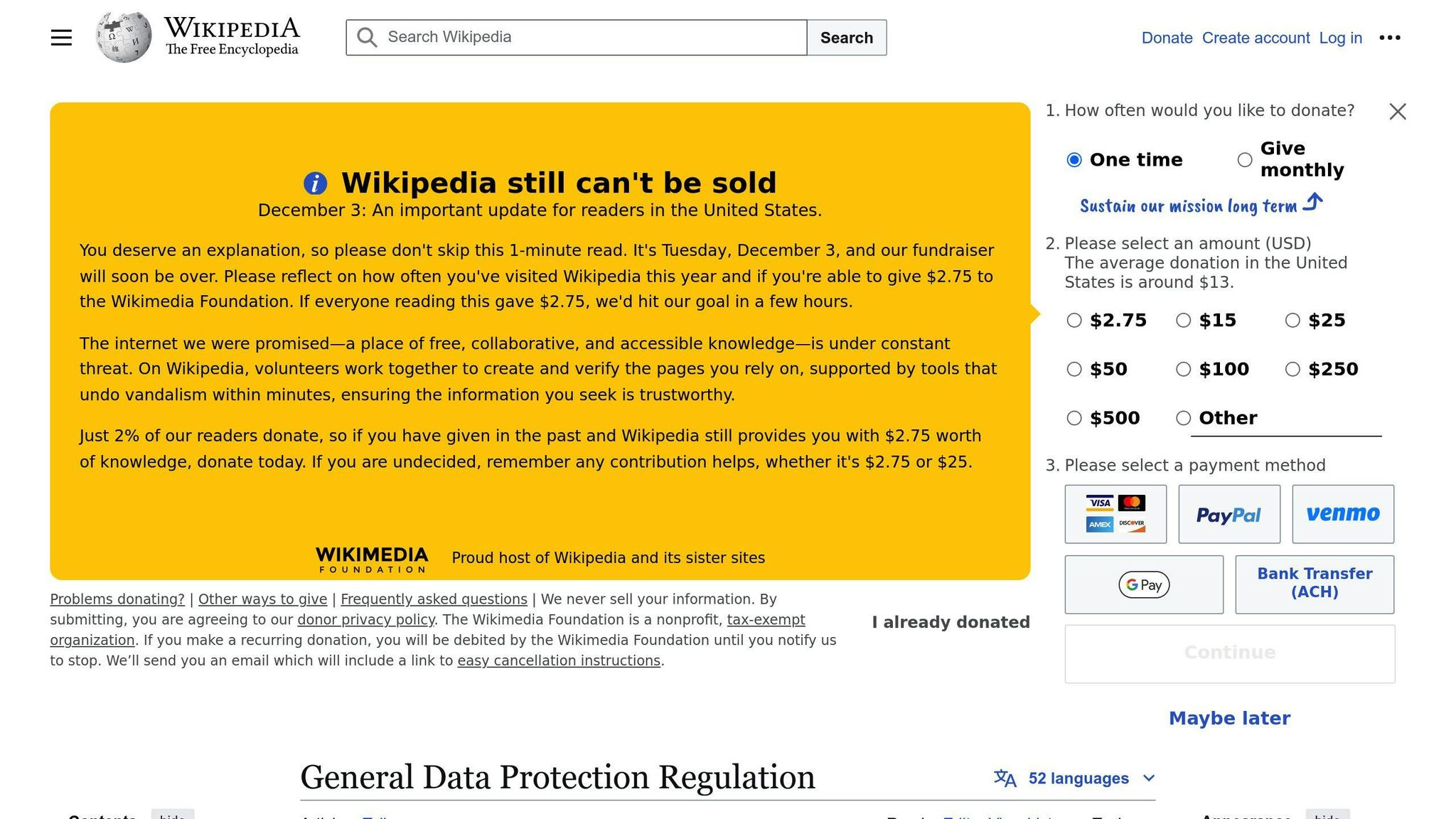Creating GDPR-compliant online forms is crucial to protect user data privacy and avoid penalties. Here are the key best practices:
Get Clear User Consent
- Use simple language to explain what data you collect and how it will be used
- Avoid pre-checked consent boxes, allow users to actively opt-in
- Separate consent from other agreements like terms and conditions
Record User Consent Properly
- Maintain a log of who consented, when, how, and what they consented to
- Use consent management tools to streamline the process
Make Forms Clear and Transparent
- Explain data use clearly, avoiding vague terms
- Provide an easy way for users to withdraw consent
Secure User Data and Privacy
- Encrypt user data during collection and transmission
- Have a protocol to handle data breaches properly
Continually Improve GDPR Compliance
- Analyze form performance metrics like conversion and bounce rates
- Stay updated with the latest GDPR regulations and guidelines
By following these best practices, you can build trust with users, protect their personal data, and avoid costly penalties.
Related video from YouTube
Get Clear User Consent
Getting clear user consent is a crucial aspect of creating GDPR-compliant online forms. This involves designing forms that capture user consent in a manner that is informed, freely given, and unambiguous.
Writing Clear Consent Requests
When crafting consent requests, use simple and straightforward language that explains exactly what data you're collecting, why you need it, and how it will be used. Avoid using jargon or complex terminology that may confuse users.
Here's an example of a clear consent request:
"I consent to allow [Company Name] to collect and store my personal data for the purpose of [specific purpose]."
Avoid pre-checked consent boxes, as this can be seen as coercive and may not constitute valid consent under GDPR. Instead, leave the checkbox blank and allow users to actively opt-in by checking the box themselves.
Separating Consent from Other Agreements
Separate consent from other agreements, such as terms and conditions. This ensures that users are not forced to agree to terms they may not fully understand or agree with in order to provide consent.
Here's an example of how to separate consent from other agreements:
| Consent | Terms and Conditions |
|---|---|
| I consent to allow [Company Name] to collect and store my personal data for the purpose of [specific purpose]. | [Link to terms and conditions] |
By following these best practices, you can ensure that your online forms capture user consent in a way that is GDPR-compliant and respectful of users' rights.
Record User Consent Properly
Recording user consent is a critical aspect of GDPR compliance. You must be able to demonstrate that you have obtained valid consent from users to process their personal data.
Keeping Consent Records
To keep consent records, maintain a log of the following information:
| Information | Description |
|---|---|
| Who consented | User ID, email address, or other identifiers |
| When they consented | Timestamp |
| How they consented | Checkbox, opt-in form, etc. |
| What they consented to | Specific data processing activities |
| If and when they withdrew consent | Date and time of withdrawal |
This information should be stored securely and be easily accessible in case of an audit or investigation.
Using Consent Management Tools
Consent management tools can simplify the process of recording and managing user consent. These tools can help you to:
- Create and manage consent forms
- Track and record user consent
- Provide users with easy ways to withdraw their consent
- Demonstrate compliance with GDPR requirements
Examples of consent management tools include Iubenda's Consent Database and other similar solutions. These tools can help you to streamline your consent management processes and reduce the risk of non-compliance.
By keeping accurate records of user consent and using consent management tools, you can ensure that you are meeting the GDPR's requirements for consent and protecting the rights of your users.
Make Forms Clear and Transparent
When creating GDPR-compliant online forms, it's essential to ensure that they are clear and transparent. This means that users should easily understand how their personal data will be used, and they should be able to exercise their rights without any obstacles.
Explain Data Use Clearly
To explain data use clearly, use simple language and avoid technical jargon. Provide a privacy policy that outlines how you will use and protect user data. This policy should be easily accessible and written in a way that's easy to understand.
Here are some tips to keep in mind:
- Be specific: Clearly state what data you collect and how it will be used.
- Avoid vague terms: Don't use terms like "marketing purposes" or "improving user experience" without explaining what they mean.
- Provide examples: Give users concrete examples of how their data will be used, such as sending newsletters or creating personalized content.
- Make it easy to opt-out: Clearly explain how users can opt-out of data collection or request that their data be deleted.
Allow Easy Consent Withdrawal
To allow easy consent withdrawal, provide users with a clear and simple way to withdraw their consent at any stage. Here's how:
- Provide an opt-out link or button: Make it easy for users to opt-out of data collection or request that their data be deleted.
- Allow users to update their consent preferences: Let users update their consent preferences through their account settings.
- Make it clear how to request data deletion: Clearly explain how users can request that their data be deleted or forgotten.
- Provide a contact email or phone number: Give users a way to contact you to request consent withdrawal.
By making it easy for users to withdraw their consent, you can demonstrate your commitment to protecting user rights and complying with GDPR regulations.
Remember, clear and transparent forms are essential for building trust with your users and ensuring GDPR compliance. By following these best practices, you can create forms that are both user-friendly and compliant with regulations.
sbb-itb-ef9fc1a
Secure User Data and Privacy
When creating GDPR-compliant online forms, it's essential to ensure that user data is collected, stored, and transmitted securely. This section will cover the key steps to protect user data, including data encryption and proper handling of data breaches.
Encrypting User Data
To protect user data, encrypt it when collecting sensitive information, such as passwords, credit card numbers, or personal identifiable information. Use Secure Sockets Layer (SSL) or Transport Layer Security (TLS) protocols to ensure data is encrypted during transmission. Consider using end-to-end encryption, which ensures that only the intended recipient can access the data.
Handling Data Breaches Properly
Despite best efforts, data breaches can still occur. It's essential to have a protocol in place to manage data breaches efficiently and in compliance with GDPR notification requirements. Follow these steps:
| Step | Description |
|---|---|
| Identify the breach | Quickly identify the breach and assess its severity. |
| Notify affected parties | Notify the affected parties, including users and regulatory bodies, within the required timeframe (typically 72 hours). |
| Contain the breach | Take immediate action to contain the breach and prevent further unauthorized access. |
| Investigate the breach | Conduct a thorough investigation to determine the cause of the breach and implement measures to prevent future breaches. |
By following these steps, you can demonstrate your commitment to protecting user data and complying with GDPR regulations.
Remember, securing user data and privacy is an ongoing process that requires regular monitoring and improvement. By following best practices and staying up-to-date with the latest security measures, you can ensure that your online forms are both user-friendly and compliant with regulations.
Continually Improve GDPR Compliance

To ensure ongoing GDPR compliance, it's crucial to continually evaluate and refine your online forms. This section will cover the importance of analyzing form performance and updating compliance measures to stay ahead of legal requirements.
Analyze Form Performance
Regularly review your form's performance to identify areas that may impact user experience and GDPR compliance. Look at metrics such as:
| Metric | Description |
|---|---|
| Conversion rates | Are users completing your forms, or are they abandoning them due to complexity or unclear consent requests? |
| Bounce rates | Are users leaving your site or form due to concerns about data privacy or security? |
| User feedback | Are users providing feedback on your forms, and if so, what are their concerns or suggestions? |
By analyzing these metrics, you can identify areas for improvement and make data-driven decisions to optimize your forms for better user experience and GDPR compliance.
Update Compliance Measures
GDPR regulations are not static, and it's essential to stay up-to-date with the latest legal interpretations and guidelines. Regularly review and update your compliance measures to ensure they align with the latest requirements. This includes:
- Monitoring regulatory updates and changes to GDPR guidelines
- Participating in industry forums and discussions to stay informed about best practices
- Conducting regular audits and risk assessments to identify potential compliance gaps
By staying proactive and adapting to changes in GDPR regulations, you can demonstrate your commitment to protecting user data and maintaining trust with your audience.
Remember, GDPR compliance is an ongoing process that requires continuous evaluation and improvement. By analyzing form performance and updating compliance measures, you can ensure that your online forms remain user-friendly and compliant with regulations.
GDPR Compliance is an Ongoing Process
GDPR compliance is not a one-time task. It requires continuous evaluation and improvement to ensure your organization stays compliant with the regulations.
Key Points for Compliant Online Forms
To ensure your online forms remain GDPR-compliant, remember to:
- Obtain clear and specific user consent
- Record user consent properly
- Make forms clear and transparent
- Secure user data and privacy
- Continually improve GDPR compliance
By following these best practices, you can build trust with your users, protect their personal data, and avoid costly penalties and reputational damage.
Building Trust Through Compliance
GDPR compliance is essential for building stronger, more transparent relationships with your customers. By prioritizing user privacy and data protection, you demonstrate your commitment to their well-being and security. This can lead to increased loyalty and business success.
By embracing GDPR compliance as an ongoing process, you can stay ahead of the curve, mitigate risks, and create a culture of transparency and accountability within your organization.
| Benefits of GDPR Compliance | Description |
|---|---|
| Builds trust with users | Demonstrates commitment to user privacy and data protection |
| Protects personal data | Ensures secure collection, storage, and transmission of user data |
| Avoids penalties | Reduces the risk of costly fines and reputational damage |
| Increases loyalty | Fosters stronger, more transparent relationships with customers |
| Enhances business success | Contributes to long-term business growth and success |
FAQs
How to Make a Form GDPR Compliant?
To make a form GDPR compliant, you need to get clear and specific user consent. This means:
- No pre-ticked boxes, as consent under GDPR needs to be freely given.
- Use clear language to explain what the user is agreeing to by ticking the box.
- Make it easy for users to withdraw their consent.
How Do I Create a GDPR Compliant Consent Form?
When creating a GDPR compliant consent form, remember to:
| Best Practice | Description |
|---|---|
| Clearly name your organization | Identify your organization and any third parties relying on the user's consent. |
| Avoid pre-ticked checkboxes | Ensure users actively opt-in by ticking the box themselves. |
| Separate GDPR consent requests | Keep GDPR consent requests separate from terms and conditions. |
| Provide granular consent options | Offer separate consent options for different data processing activities. |
| Make it easy to withdraw consent | Allow users to easily withdraw their consent at any stage. |

